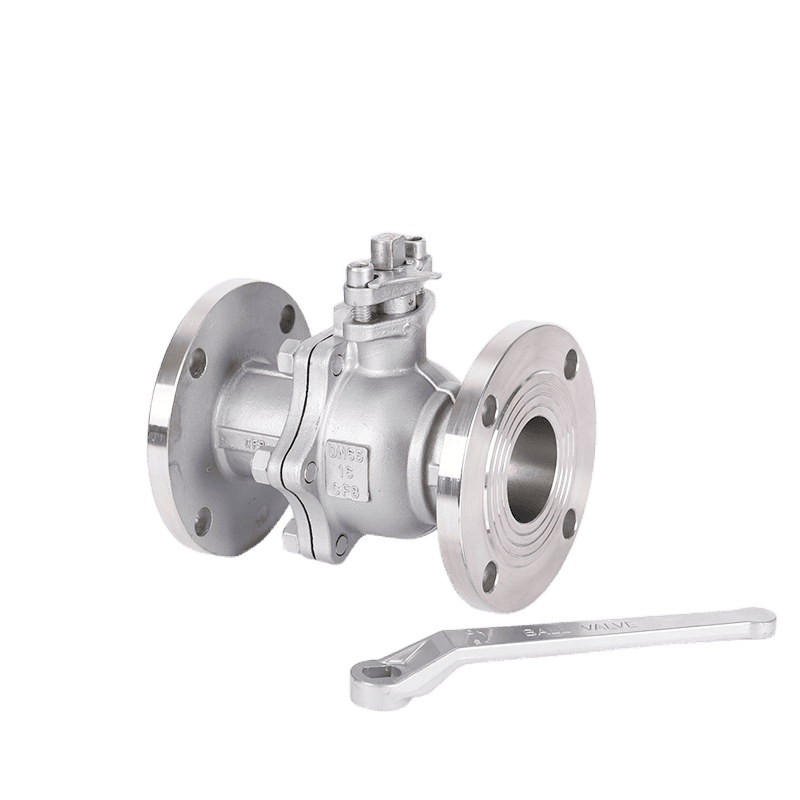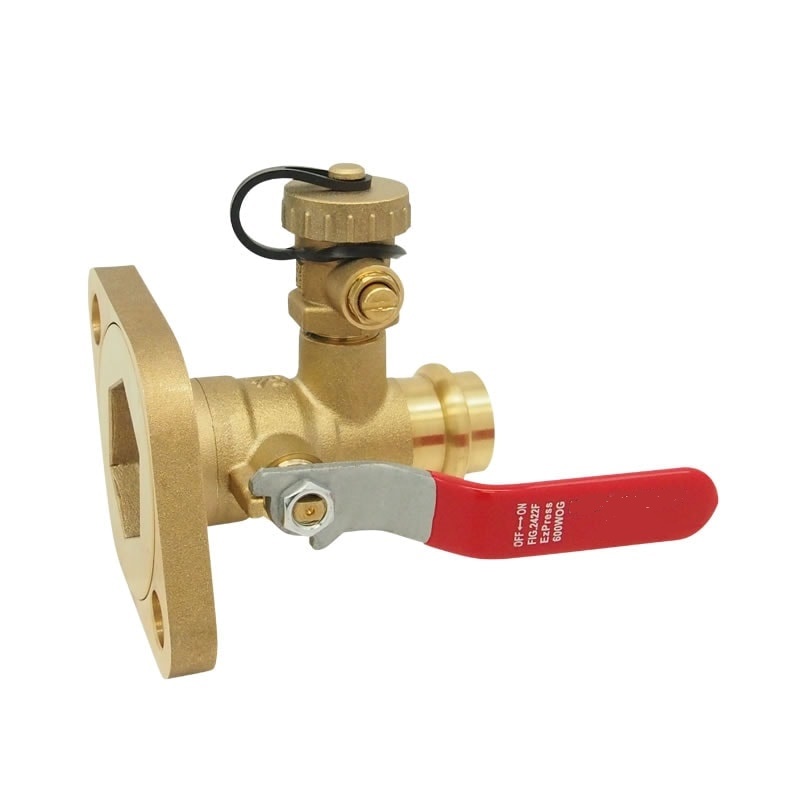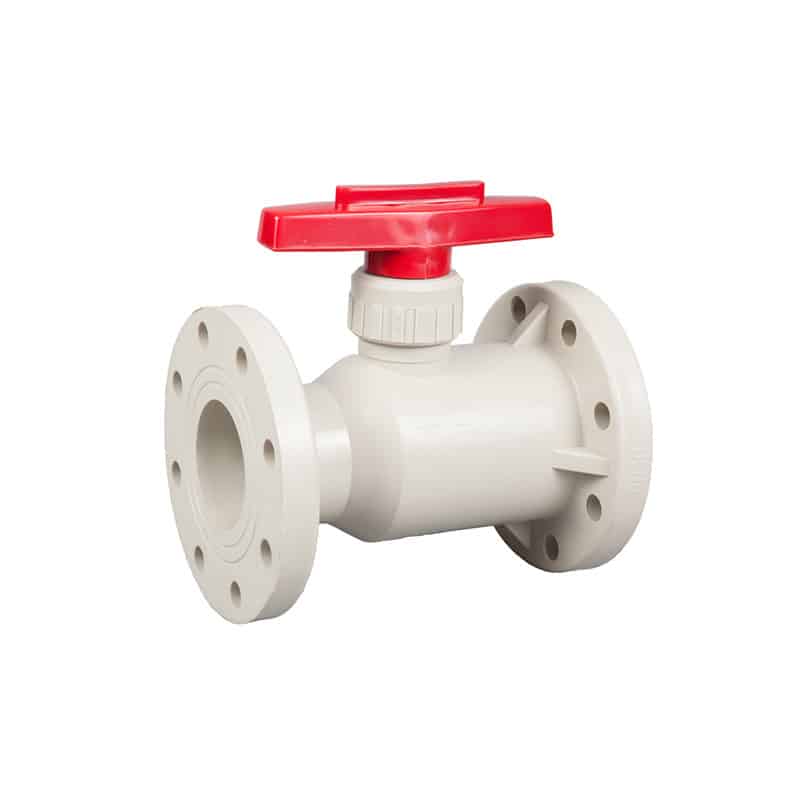A ball valve is an isolating type of valve. It is used to allow & prohibit the process media flow through the piping system. Ball valves come in different styles and are usually made of different materials. Which affects how they can be used. A flanged ball valve is a ball valve designed to have flanged ends. One can use it for shutoff applications. The usage is in hydraulic circuits. A flanged-type ball valve allows the operating fluid to flow when needed. It is very effective in providing positive leak-tight closure. For regulating or throttling purposes, a flanged-type ball valve is not suitable.
The flanged ball valve is made of carbon steel, stainless steel, or brass. These materials are perfect for tolerance to temperature and corrosion resistance. It makes them robust. This ball valve is a control component in the piping flow system. A spin of 90 degrees with a small torque is enough to close the.
Industries use flanged-type ball valves. It comes to transporting water or other liquids at low to high pressures. Flanged ball valves can start and stop the flow of fluids. It also provides the facility to change pipes without disrupting the entire line.
This type of ball valve is only different from other ball valves on the exterior. Besides the flanges, these valves contain a ball with at least two holes or ports. The standard primary ball valve has one inlet and one outlet with a hole. When rotated 90°, the hole moves vertically to the passageway and blocks the flow.

L-type ball valves have two short bored holes and meet at a right angle in the middle. The ball can be revolved a quarter turn and connect the inlet to the outlet. When the ball rotates a quarter turn in the other direction, it will connect to a second outlet. T-type flanged ball valves have three holes, which meet in the center to form a T shape.
The current can move into both outlets or to one or the other. The ball can differ in size. A full port ball valves have a ball more prominent than the passage’s size, and the hole is the same diameter as the pipe. There is no flow limit for valves of this kind because the pipe walls are flush with the hole. Compact port balls have small balls with even smaller holes that make it hard to move around.
Components of a Flange-Type Ball Valve
- Body
- Cap
- Ball
- Seat
- Joint gasket
- Seat rings
- Stem Packing
- Gland Nut
- Stem
- H-spring Washer
- Handle Nut
- Nut
- Spring Washer
- Handle Cover
- Thrust Washer
- Locking Device

Flange Ball Valve Operation
- When the valve is used within its rated range, you can maximize its operational life.
- Keeping the flange ball valve in throttled position is not always good, and it may cause damage & seat life.
- A Gear unit or An Actuator (Electric / Hydraulic / Pneumatic) helps the flange-type ball valve to rotate quarter-turn.
Gear Unit: The clockwise operation of a flange-type ball valve is for closure. The anti-clockwise is for the opening of the valve. It is possible by using the location indicator, which is on the side of the gear panel. Forcing the handwheel or the chain wheel alongside the stops will not provide a suitable valve shutoff and may damage the gear unit.
Actuator: The actuator controls the gear assembly and rotates the shaft. Electrically actuated valves are fixed for the manual control of the valve. The pneumatic/hydraulic actuators are fitted directly to the valve without a gear connection.
Handling:
- Before moving the valve, it must be correctly stayed and protected. Otherwise, possible damage to the valve and property will happen.
- During any movement, the valve should not be dragged to the ground. A minimum height should be maintained.
- One must not hang the crane wire around the actuator/gear unit. When handling the valve, you should ensure that no external load acts on the actuator/gear unit.
- One should not handle the valves with the handwheel fixed to the gear unit. We should disassemble the handwheel before handling and transporting the valve.

Storage:
- The valves must be kept in a safe environment. Dust and humidity may damage the valves. The area should be well-ventilated.
- Before putting the valve in, you must make sure that the end protectors are in place. If not, dry pollutants like dust, sand, and grit can scratch the metal surfaces and parts of the seats, which can cause leaks when the car is being serviced.
- One should keep the valve at a temperature more significant than the dew point temperature at the storage location. It will help to prevent the increase of water droplets on the valve sheet.
- It is against the law to leave the valve on the floor. We can put the valve on a wooden pallet so that it is just above the floor. We must always take care not to damage any parts of the adaptor, gear unit, or actuator that protrude during storage.
- Non-compatible grease or any other material inside the valve is prohibited. It may malfunction the valve.
- A nontoxic coating of “Manganese Phosphate” was used for the steel valves. It slows down the creation of rust during storage. With their natural finish, you can use stainless steel valves also. It may not require any additional protection because of its natural finish.
Instructions for Using Flange Ball Valve
- Assembling and disassembling of flange-type ball valves depends on the relief of upstream and downstream pipes. One should take out non-metal parts instantly after cleaning. These should not be drenched for a long time in the cleaning agent, which should be well-matched with the rubber parts, plastic parts, metal parts, and working medium like gas. We can use gasoline as a cleaning agent for metal parts when the working medium is fuel gas. Using grease is compatible with flange ball valve metal materials.
- The bolts on the flange must be tightened correspondingly & steadily.
- We can clean all parts of the flange ball valve by sinking these into cleaning solutions. A clean silk cloth soaked with a cleaning agent can scrub the non-metallic elements. Washing the parts in cleaning agents for an extended period is not good. It may get rusted. Grease, dirt, glue, dust, etc., adhering to the wall should be removed while cleaning.
- Non-metallic parts are susceptible. Pure water or alcohol can be used for cleaning non-metal parts. We should be conscious while disassembling and reassembling the flange ball valve to inhibit damage to the sealing surface of the details.
- During assembly, One should ensure that any metal debris, fibres, grease, dust, and other foreign impurities do not contaminate the surface of the parts. Enter into the inner cavity of the valve should be monitored.

Installation of Flange Ball Valve
Before installing a Flange Ball Valve, we should concern about the following necessary steps:
- The front and rear pipes should be coaxial. The sealing tops of the two flanges should be parallel. The pipeline should be able to bear the weight of the valve. If it is impossible, the channel must be equipped with proper support.
- To remove oil, welding slag, and all other impurities present in the pipeline, we should run an expulsion procedure of the channels.
- The flange ball valve should be fully intact. For this, we can check the sign of the flange ball valve and make sure. We should also make sure that the valve is working correctly. We can check it by opening and closing the valve several times.
- Eliminate the protective parts of the flange ball valve at both ends of the connecting flanges.
- Check the valve hole to eliminate and clean any possible filth. Even small foreign particles between the valve seat and the ball may harm the sealing surface of the valve seat.
Installation Procedure:
- A handle drives the flange-type ball valve. The handle can be installed at any place on the pipeline. Sometimes a flange ball valve is caused by a gearbox or has a pneumatic drive. The pneumatic drive should be installed upright or installed on a horizontal pipeline. The driving device should be straight above the channel.
- There needs a gasket between the valve flange and the pipeline flange. The gasket should be installed according to the pipeline design requirements.
- The bolts on the flange should be tightened symmetrically and consecutively.
Inspection
- To inspect, operate the valve with a driving tool to open and close the flange ball valve several times. This operation should be flexible. We have to confirm that the valve is working appropriately.
- A proper flange joint between the pipeline and the flange ball valve is necessary. It should be according to the design requirements of the channel.
Maintenance & Repair of Flange Ball Valve
To get a longer service life and maintenance-free period for flange-type ball valves, we should maintain a good temperature/pressure ratio. The following provisions should be taken while carrying out repair and maintenance of the Flange Ball Valve:
- Ensure that fluid is under pressure inside the valve even after shutting off the flange ball valve.
- Discharge the line pressure and leave the valve open before servicing the flange ball valve.
- Separate the power or air supply from the driving mechanism before repairing the flange ball valve.
- Detach the actuator from the bracket before maintenance.
- Discharge only the upstream and downstream pipelines of the flange ball valve before disassembly.
Replacement of seats and seals
- Ensure that the pipeline has been reduced, depressurized, and emptied.
- Loosen and remove the flange screws and nuts.
- Spread the flanges using a proper tool and remove the valve.
- Close the valve.
- Loosen and remove the hexagon nuts from the stud bolds.
- Eliminate the body connector from the body.
- Eliminate seats, ball, and body seal. Be careful about any damage.
- Eliminate the handle nut/screw and hand lever.
- Take off the gland flange and disk spring washers and remove the gland.
- Push the stem into the valve body and remove it carefully.
- Eliminate the thrust washer and primary sealing from the branch.
- Remove stem packing and thrust washer.
- Clean all parts, especially the sealing surfaces of the ends.

Assembly of Flange Ball Valve
- Clean and review all the removed parts.
- It is suggested to substitute the seals, valve seat, and bonnet gasket with a spare part.
- Tighten the flange connection bolts crosswise with the indicated torque.
- Tighten the stem nut with the listed torque.
- After installing the actuator, put the corresponding signal. It helps to rotate the valve core.
- Having a pressure seal and performance test on the valve will be good. This test should occur according to related standards.
- There shouldn’t be any leakage in the packing. The stem nut must be locked again or replaced with the valve seat and seal if any leakage is found.
Disassembly of Flange Ball Valve
- Stay the valve in the half-open position to flush. Eliminate the dangerous substances that may exist inside and outside the valve.
- Eliminate the connecting bolts and nuts on the flanges on both sides. After that, remove the valve from the pipeline entirely.
- Take the drive device actuator, connecting bracket, anti-loosening washer, valve stem nut, butterfly spring, wear plate, and valve stem packing.
- Remove the body cover connecting bolts and nuts. Detach the valve cover from the valve body and remove the valve cover gasket.
- Ensure the flange ball valve is in the “off” position. Now the valve body can be easily detached. After that, one should remove the valve seat.
- Push the stem lightly through the hole in the valve body until it is completely removed. After that, remove the O-ring and the packing under the branch.
Application & Use of Flanged Ball Valve:
Most of the time, a ball valve is used to turn it on and off a pipe. It has solids, slurries, liquids, or gases in suspension. Ball valves are also used a lot in tubing systems, equipment, and tools used to move fluids. They are everywhere, from the factory floor to your house. Manufacturing, mining, oil and gas, agriculture, heating and cooling, plumbing, water consumer goods, construction, and other industries use it.

Advantages of Flanged Ball Valve:
- Cost-effective automation and safe connection
- Low-pressure loss
- Face-to-face dimension
- High-quality guarantees
- High security
- Direct mounting
- Flange connection
- Stainless steel hand lever
- Reliable stem sealing
- Safe sealing
- Antistatic design
- Super-polished ball surface
- Anti-blowout stem
